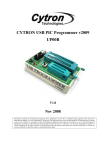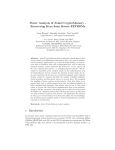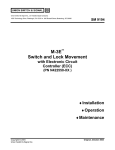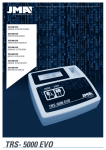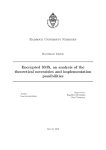Download Fuming Acid and Cryptanalysis
Transcript
Fuming Acid and Cryptanalysis:
Handy Tools for Overcoming a Digital Locking
and Access Control System
(Full Version)
Daehyun Strobel, Benedikt Driessen, Timo Kasper, Gregor Leander,
David Oswald, Falk Schellenberg, and Christof Paar
Horst Görtz Institute for IT-Security
Ruhr-University Bochum, Germany
Abstract. We examine the widespread SimonsVoss digital locking system 3060 G2 that relies on an undisclosed, proprietary protocol to mutually authenticate transponders and locks. For assessing the security of
the system, several tasks have to be performed: By decapsulating the
used microcontrollers with acid and circumventing their read-out protection with UV-C light, the complete program code and data contained
in door lock and transponder are extracted. As a second major step, the
multi-pass challenge-response protocol and corresponding cryptographic
primitives are recovered via low-level reverse-engineering. The primitives
turn out to be based on DES in combination with a proprietary construction.
Our analysis pinpoints various security vulnerabilities that enable practical key-recovery attacks. We present two different approaches for unauthorizedly gaining access to installations. Firstly, an attacker having
physical access to a door lock can extract a master key, allowing to mimic
transponders, in altogether 30 minutes. A second, purely logical attack
exploits an implementation flaw in the protocol and works solely via the
wireless interface. As the only prerequisite, a valid ID of a transponder
needs to be known (or guessed). After executing a few (partial) protocol
runs in the vicinity of a door lock, and some seconds of computation, an
adversary obtains all of the transponder’s access rights.
Key words: Access control, electronic lock, reverse-engineering, realworld attack, hardware attack, cryptanalysis, wireless door openers
1
Introduction
Despite the fact that nowadays strong and well-analyzed cryptographic primitives are available for a large variety of applications, very weak cryptographic
algorithms are still widely deployed in real products all over the world. Examples
include algorithms like Keeloq or the Crypto1 cipher used in the Mifare Classic
cards. It is very surprising how big a gap between cryptographic theory on the
one hand and cryptographic protocols in real products on the other hand exists
and how real-life products have their security mainly based on obscurity and not
on cryptographically sound protocols and primitives.
In this paper, we add one more interesting example to the list of widely
deployed ciphers that have severe design flaws. Our hope is that the presented
findings contribute to the science of building more secure wireless systems.
1.1
(Digital) Locking Systems and Wireless Technology
For many decades, purely mechanical keys and locks were the only means for
securing the access to buildings, rooms, cars, and other property. Starting in the
1950s, the first Remote Keyless Entry (RKE) systems were available on the market to open doors from a distance via a Radio Frequency (RF) interface. These
“fixed-code” systems provided no cryptographic protection and could easily be
circumvented by means of a replay attack. In the 1980s, manufacturers started to
equip cars with this type of wireless door opener on a large scale. After the number of stolen cars rose, it became clear that the new wireless comfort came at the
price of reduced security and that more elaborate authentication schemes were
required to prevent theft. Combining the benefits of modern wireless technology
and cryptography, a new era of access control systems began: Immobilizers and
more secure RKE systems were invented and today, all new cars are furnished
with remote controls incorporating cryptography, while purely mechanical keys
have almost vanished from the market.
Recently, a similar trend can be observed for the access control to buildings.
While mechanical keys and locks are still widespread, they suffer from certain
disadvantages. For example, keys can often easily be copied and if a key gets
lost or stolen, all affected door locks have to be replaced. Also, mechanical locks
only allow a rudimentary type of access management. The demand for a flexible assignment of keys to locks and vice versa paved the way for augmenting
mechanical locks with wireless technology and replacing mechanical keys by electronic counterparts, e. g., transponders or smartcards. In case of loss or theft,
administrators can simply block affected transponders in a database.
Despite all these comforts and benefits, wireless communication implies an
increase in attack surface: A transponder residing in a pocket or wallet could be
read out or modified without the owner taking note of it. Moreover, the transmission of data via the RF interface can be monitored from a distance. Hence,
wireless access control systems require protecting the over-the-air interface with
additional security measures.
1.2
Related Work
In the world of access control by electronic means, various manufacturers have
been inventing their own cryptographic primitives and protocols, often with lowcost properties and established “security” by keeping the details secret. The past
decade has shown that the vast majority of these schemes is flawed and that
once the ciphers have been reverse-engineered and become public, they can be
broken with low to modest efforts.
One of the first examples is the DST40 cipher. It is used in Texas Instrument’s Digital Signature Transponder (DST) and has been reverse-engineered in
2005 [1]: Knowing at least two challenge/response pairs, the 40-bit secret key of
a corresponding transponder can be revealed by means of a brute-force attack
in less than one day. Likewise, following the reverse-engineering of NXP’s Mifare Classic cards [2] through analyzing the silicon die, the used Crypto1 cipher
was found to be weak, relying on a state of only 48 bits. Further mathematical
weaknesses of the cipher and implementations flaws, e. g., a weak random number generator, enable to reveal all secret keys and practically circumvent the
protection mechanisms with a card-only attack in minutes [3–5]. The Hitag 2
transponders of the same manufacturer, widely used for car immobilizers—but
also for RKE systems—were found to be flawed after the cipher became public [6]. Based on the latest results [7], their secret keys can be extracted in
six minutes. Further insecure products for access control include HID Global
iClass [8] and Legic Prime cards, both based on highly ineffective cryptographic
measures [9].
Practically exploiting the vulnerabilities of the above products typically requires to be at least in the vicinity of the targets (cars, cards, card readers in the
buildings, etc.). In contrast, attacking the RKE system KeeLoq is feasible from a
larger distance: After the cipher became public, mathematical weaknesses were
found [10, 11] and—after performing a side-channel attack to obtain the master
key of the system—duplicating remote controls is feasible by means of eavesdropping from several hundred meters [12].
1.3
SimonsVoss Digital Locking and Access Control System 3060
One large manufacturer of digital locking systems for buildings is the Germanybased company SimonsVoss Technologies AG. SimonsVoss, the European market
leader for electronic locking and access control systems [13], installed its one millionth digital locking cylinder in April 2012 and has sold more than three million
corresponding transponders. The list of customers and objects secured with this
technology in Europe, USA, and Asia, as listed on the official website [14], is very
impressive: It includes residential buildings, tourist apartments, hospitals, universities, embassies, major banks, airports, buildings of the German armed forces
and the US army, factory sites of well-known brands, police stations, stadiums,
town halls, prisons, insurances, and many others.
One part of the system, termed transponder, serves as a substitute for a
mechanical key. It is a battery-powered remote control that, upon pressing a
button, activates the second part of the system, an electronically enhanced cylinder. The cylinder that is integrated into the door has the same dimensions as
a standardized mechanical locking cylinder. If successfully activated, the door
cylinder beeps twice, indicating that the lock can be opened or closed during the
next few seconds (with manual force, by turning a knob that is attached to the
cylinder).
(a)
3064
Transponder (b) Door lock cylin- (c) Battery replace- (d) Opened
der 3061
ment tool
knob
lock
Fig. 1. Components of the digital locking system
The digital cylinder is also powered from batteries. In case of worn-out batteries after a few years of operating time or exceptional operating conditions1 , they
can be replaced after dismantling the knob of the cylinder with the commercially
available “battery replacement tool” (cf. Fig. 1c). The electronics are contained
inside the knob of one side of the door cylinder, as illustrated in Fig. 1d, while
the other knob is usually empty. The correct side for a battery change can be
visually identified by a small, black plastic ring that is visible between the cap
of the knob and the metal parts of the cylinder. This knob should be installed
inside the buildings or inside the offices to prevent unauthorized access to the
electronics.
The widespread digital locking system 3060 analyzed in this paper is based
on a so far undisclosed, proprietary cryptographic protocol. The latest revision is
termed “Generation 2” or “G2-based” system by the manufacturer. It supports up
to 64,000 digital locking cylinders 3061 (cf. Fig. 1b) per installation, up to 64,000
transponders 3064 (cf. Fig. 1a) per lock, and the storage of up to 1,000 access
instances on the transponder. The cost of a transponder 3064 is approx. $ 40 and
that of a locking cylinder 3061 approx. $ 440.
The back-end of larger installations is realized as a software running on a
standard PC, allowing to configure all door locks of an installation via a wireless
link, e. g., in order to re-program the door locks. Likewise, transponders can be
programmed to enable access to certain doors by means of the functionality of the
back-end. In general, the “Generation 2” system enables to form a network of door
cylinders, transponders, and the back-end by means of various communication
techniques, e. g., through Ethernet or through multiple routers and nodes (cf.
[15]). Small installations can also be configured offline, using the programming
transponder 3067.
The door locks can have a permanent connection to a central server through
multiple wireless access points (“WaveNet router nodes”) at 868 MHz. These
router nodes connect to so-called lock nodes [16] placed within the door knob.
Lock nodes in turn communicate over a single wire with the circuitry responsible
for opening the lock and the 25 kHz connection to the transponders. The (successful or unsuccessful) opening attempt of any transponder at any door lock in
1
The batteries need to be replaced in intervals of up to 10 years or 150,000 door
openings according to the information of the manufacturer.
the system can be monitored and stored in logfiles. In case of an electrical power
outage or when communication between door locks and back-end is interrupted,
doors remain fully functional [17, p.5]. The security of the back-end and the
wireless link are explicitly not analyzed in this paper. All our findings in the
following are solely based on analyzing the door locks and transponders.
1.4
Contribution and Outline
The security level of access control systems relying on the obsolete ciphers mentioned in Sect. 1.2 has already been evaluated and in most cases has been found to
be very low. However, to the best of our knowledge, the security of the widespread
SimonsVoss digital locking system 3060 “Generation 2” and its proprietary, undisclosed schemes for encryption, authentication, and key derivation has not been
publicly evaluated yet. The aim of this paper is to close this gap and analyze
the security of this system.
By eavesdropping the communication between transponder and lock, it quickly
became clear that the protocol is rather involved, with each protocol run consisting of 11 messages being exchanged. Moreover, as non-trivial computations are
executed, extracting the details of the protocol by eavesdropping only seemed
out of reach. Thus, more invasive methods were needed to advance at this step:
In Sect. 2, we reverse-engineer the hardware and software of transponders and
digital cylinders, by means of decapsulating chips with acid, circumventing readout protections with UV-C light, and analyzing the internals with a microscope
and disassembler. As a result, the proprietary authentication scheme is disclosed
in Sect. 3 and all details about the proprietary cryptographic primitives and the
key derivation mechanism are given in Sect. 4. Compared to various antiquated
access control systems (cf. Sect. 1.2), the SimonsVoss realization at a first glance
appeared to provide an adequate security level, since a slightly changed version
of the Data Encryption Standard (DES) combined with a proprietary obscurity
function is applied.
The next step of our work thus consists in cryptanalyzing the cipher and the
protocol (cf. Sect. 5). Most surprisingly, due to a crucial flaw in the protocol,
the (modified) DES can be circumvented completely. This allowed us to mainly
focus on the proprietary obscurity function. After our detailed analysis it turns
out that this function can be seen as a (generalized) T-function (cf. [18]), which
is the key to invert (parts of) the obscurity function very efficiently.
Our work finally resulted in very practical attacks which enable opening
the doors secured by the analyzed system, as illustrated in Sect. 5: An adversary
possessing an ID of an valid transponder (for instance obtained by eavesdropping,
exhaustive search, or reading it out from a transponder or door lock) simply has
to execute a few (partial) protocol runs in the vicinity of a door lock to obtain
all access rights the respective genuine transponder possesses. The attack works
solely via the wireless interface, thus leaves no traces, and does not require
physical access to a valid transponder or lock.
2
Reverse-Engineering
When initially analyzing the SimonsVoss System 3060, we were facing a complete black-box, i. e., had no information on the inner workings of the system.
From publicly available information, little can be learned about the actual implementation. Hence, we decided to obtain the necessary knowledge for our security analysis by reverse-engineering the involved components. The Printed Circuit Boards (PCBs) of transponder and door (cf. Fig. 2a) have a similar layout
containing three main components that are involved in the authentication process: A SimonsVoss-proprietary Application Specific Integrated Circuit (ASIC)
is connected to a Microchip PIC16F886 Microcontroller (µC) [19]. The third
component is an external Electrically Erasable Programmable Read-Only Memory (EEPROM) controlled by the µC over an Inter-Integrated Circuit (I2 C)
bus [20]. In this section, we summarize the results of reverse-engineering the
functionality of these components.
2.1
Reverse-Engineering the Proprietary ASIC
Since we could not obtain any documents regarding the functionality of the
ASIC, we decided to analyze the device on the level of the silicon die. To this
end, we decapsulated several ASICs using White Fuming Nitric Acid (WFNA)
according to the two-step procedure as described in [21, p.10] and took highresolution pictures of the die with an optical microscope. We found that the
ASIC employs a 2 µm gate array design with a total number of 2320 transistors available for CMOS logic. In consequence, the amount of logic that can be
implemented is rather limited and insufficient to, e. g., realize cryptographic algorithms. After reverse-engineering most of the digital circuits of the ASIC we
found out that the main functions of the ASIC are (1) to implement functions
to wake up the µC periodically and (2) to work as a (de)modulator for the RF
transmission.
2.2
Reading out the Firmware of the PIC16F886
Having found that the ASIC is not related to the security-relevant parts of the
system, it can be assumed that all (cryptographic) functionality is implemented
in the firmware of the Microchip PIC16F886 [19] µC. Like many common µCs,
this PIC stores its firmware in an internal flash memory. Moreover, the µC
contains an internal EEPROM for storing 256 bytes of user-defined data. In
order to protect the firmware and the content of the EEPROM, SimonsVoss
enabled the read protection fuse.
After unsuccessful attempts to clear the respective configuration bits using power glitches during the programming operation, we considered a different method: In [22], the author successfully cleared the configuration bits of
a PIC18F1330, i. e., changed the state from 0 to 1 by applying UltravioletC (UV-C) light in a certain angle to the decapsulated chip. The idea is that
even if the fuses are covered with a (small) metal plate as a shield, UV-C light
will bounce off from various parts around the metal plate and the plate itself,
eventually hitting the cells storing the fuse bit. In [23], the author confirmed
that the attack worked for a PIC12F683 as well.
(a) PCB (front) of the (b) PIC16F886 (c) PCB after decap- (d)
Exposure
to
door part
annotated (ana- sulation,
memories UV-C light of an
log to [23])
covered with tape
EPROM erasure tool
Fig. 2. PCB of the door circuitry, location of the security bits (fuses) and erasing fuses
of the PIC16F886
Although the PIC16F886 comes in a relatively new type of package (QFN),
Microchip did not address this issue and leaves the UV-C attack still possible.
We decapsulated the µC with WFNA and used an EPROM erasure tool [24]
as our UV-C source (cf. Fig. 2d). After testing various positions and angles,
we found that all non-volatile memories and the configuration bits were erased
after an exposure of about 20 min. By applying this technique exclusively to
the configuration bits, i. e., by covering the non-volatile memories with electrical
isolation tape (cf. Fig. 2b and 2c), we were able to recover the complete firmware
(stored in the internal Flash memory) and the contents of the internal EEPROM
of several transponders and door lock µCs.
In order to disassemble and understand the code running on the µC of both
the transponder and the door lock, we utilized IDA Pro [25], a tool often employed for the analysis of regular PC-software. Nevertheless, IDA Pro also includes a module for PIC µCs which greatly aided in the reverse-engineering
process. In addition to performing a static analysis of the program code with
IDA Pro, we also inserted debug routines into the disassembled code. This routine allows to dump the registers and the SRAM during the execution of the
program on the original transponder or door PCB over an unused pin of the
µC. Thus, being able to dump the memory contents, e. g., during the execution
of a successful authentication protocol run, we were able to verify the results of
the static analysis and to understand parts of the code that heavily depend on
external input (e. g., from the external flash).
3
Authentication Keys & Protocol
In the following, we present the essential results of reverse-engineering the software running on the transponder and the lock. We focus on the keys, protocol,
and the cryptographic primitives used to mutually authenticate transponders
and locks.
For a successful execution of the authentication protocol, transponder and
lock must be in possession of a shared secret. For this purpose, each transponder
has a (unique) 128-bit long-term secret KT . This key is computed from a 128-bit
value KT,ext stored in the external EEPROM and a 128-bit key KT,int stored in
the PIC’s internal EEPROM as
KT = KT,ext ⊕ KT,int .
On the other hand, each lock stores a set of four 128-bit keys KL,j that are
identical for every lock in the entire installation. Analogous to the transponder’s
key, one of these keys KL,j is the XOR of a key KL,j,ext stored in the external
EEPROM with one 128-bit internal key KL,int stored in the internal EEPROM,
i. e.,
KL,j = KL,j,ext ⊕ KL,int
with 0 ≤ j ≤ 3. In the following, we refer to the set of the keys KL,j as the
system key. Based on this key, the lock can derive any transponder key, as will
be explained in the course of the protocol.
The system uses an 11-step challenge-response protocol to achieve mutual
authentication between transponder and lock. A protocol run is initiated by
the transponder when the central button is pressed in proximity of a lock. In
the course of this authentication step, a multitude of messages is exchanged, cf.
Fig. 3.
Transponder
Lock
(has KT )
(has KL,0 , KL,1 , KL,2 , KL,3 )
preamble
−−−−−−−−−−−−−−−−−−→
ID I
←−−−−−−−−−−L−−−−−−−−
ID I
−−−−−−−−−−−T−−−−−−−→
challenge C
←−−−−−−−−−−−−−−−−−−
authentication data D
−−−−−−−−−−−−−−−−−−→
..
.
KT = K(KL,i ; IT , · · · )
response R0
R0 ||R1 = R(KT ; C, · · · ) −−−−−−−−−−−−−−−−−−→
response R1
←−−−−−−−−−−−−−−−−−− R0 ||R1 = R(KT ; C, · · · )
..
.
Fig. 3. Protocol for the mutual authentication between a transponder and a lock
Here we only focus on a subset of these messages that we identified to be
relevant for our security analysis:
IL Each lock has a 24-bit ID that is transmitted to the transponder.
IT Each transponder has a 32-bit ID that is transmitted to the door.
C After the ID exchange, the lock sends an 88-bit challenge C to the
transponder.
D The transponder sends 80 bits of authentication data to the lock. This
includes the result of its ID verification and transponder-specific data.
In the first four steps of the protocol, most of the messages are fixed for a
transponder/lock combination. Only C (and conversely the responses R0 and
R1 ) change between protocol runs—and of this 88-bit value, only 40-bit are
actually random. The remaining bits are either fixed or change infrequently. In
answer to such a challenge, both transponder and lock derive the same 64-bit
response R using the data exchanged in previous messages and the 128-bit longterm secret KT of the transponder. We denote the function to compute the
response as R, with
R = R0 ||R1 = R(KT ; IL , IT , C, D).
The main part of the authentication is then accomplished by exchanging the
following two messages:
R0 The transponder sends the first 32-bit half of R as the first response to
the lock.
R1 If R0 matches the first half of R computed by the lock, it sends the
second 32-bit half of R to the transponder.
As each party computes the full 64-bit output of R, both can verify the response
of the other party and mutually authenticate each other on the basis of KT .
Instead of storing the key KT for each transponder, a lock is able to derive KT
from a transponder’s ID IT , the authentication data D, and part of the long-term
system key. A key derivation function K is used for this purpose, i. e.,
KT = K(KL,j ; IT , D)
with 0 ≤ j ≤ 3.
4
Cryptographic Primitives
In the authentication protocol, the two basic functions K (for key derivation on
the door’s side) and R (for response computation) are used. These functions are
proprietary constructions and share two building blocks we denote as O and D.
While it turned out that D is simply a modified DES [26], what we call “the
obscurity function” O is a more intricate design, which we are describing in the
following.
The O function takes two 128-bit inputs (a plaintext and a key) and returns
a 128-bit output. Figure 4 shows the internal structure of O. This function
operates byte-wise on two registers with 16 8-bit cells. The upper registers are
continuously updated while the lower registers remain constant.
Fig. 4. Structure of the obscurity function
To compute the output of O the upper x registers are initialized with the
plaintext, while the lower y registers are set to the key. After that, the registers
are updated successively, all in all each of the x registers is updated for 8 times,
according to the following scheme: Updates start with x0 , then x1 , etc., and are
computed mostly as sums of 8-bit values modulo 256. Additionally, each cell
update incorporates an 8-bit chaining value zi , which is the result of the update
of the preceding cell. The update equation for the successive state x0i from xi is
given as x0i = yi + zi + xi mod 28 . There are basically three ways the chaining
value is computed for any round r with 0 ≤ r ≤ 7:
8
if i ∈ {0, 1, ..., 14} \ {3, 7, 11},
(xi + 2(yi + zi )) mod 2
8
zi+1 = (xi + 2(yi + zi ) + RCr+1 ) mod 2
if i = 7,
8
8
yi + zi mod 2 + xi >> 1 mod 2 if i ∈ {3, 11}.
The computation of the first value z0 is different: Initially, it is set to RC0 and
then, for the next round of cell updates it is computed as
z0 = (x15 + 2(y15 + z15 )) mod 28 .
Here, all RCr with 0 ≤ r ≤ 8 are 8-bit round constants, which we do not disclose
at this time. The function’s output is given by the contents of the x cells after
8 rounds.
4.1
K: Key Derivation Function
In the following we describe how D and O are combined to construct the key
derivation function, which is used only in the door. This function can be decomposed into three blocks, D and two instances of the aforementioned obscurity
function O, as illustrated in Fig. 5.
Fig. 5. Construction of the key derivation function
The construction has four inputs, one fixed to 64 zero bits and two other 128bit inputs that are exchanged in the authentication protocol: The value P0 , used
twice during key derivation, is composed of the first three bytes IT,0 , IT,1 , IT,2 of
the transponder ID IT and the first three bytes D0 , D1 , D2 of the authentication
data D. The last of each of these three bytes is masked by a Boolean ANDoperation with the fixed constant 0xC7 or 0x3F, respectively, thus selecting only
certain bits. All other bytes are filled with zeros, i. e.,
P0 = (IT,0 , IT,1 , IT,2 & 0xC7, D0 , D1 , D2 & 0x3F, 0, . . . , 0)28 .
Only one input of K is secret: One of the four 128-bit keys of the system key
set is selected according to the two most significant bits of the third byte of IT .
This 128-bit key is used as key KL for the first instance of O to encrypt P0 .
The output of this operation is split into two 64-bit halves which are used as
plaintext and key for D. The output of D, denoted by T , is then concatenated
with 64 zero bits, and the result is encrypted with O—using P0 as the key. The
resulting 128-bit value is the transponder’s key KT , i. e.,
K(KL ; P0 ) = O P0 ; D O(KL ; P0 )64..127 ; O(KL ; P0 )0..63 ||0 . . . 0 .
4.2
R: Response Computation Function
The structure of the response computation R is very similar to the key derivation
function K. However, the way the building blocks are combined is different.
Figure 6 shows the internal structure of R.
Fig. 6. Construction of the response computation function
Again two instances of the proprietary obscurity function O are used along
with the modified DES D. The 128-bit input P1 to R is the concatenation of the
challenge C and part of the authentication data D, i. e.,
P1 = (C0 , C1 , ..., C10 , D6 , D7 , D8 , D9 , 0)28 .
The output of the first instance of O is used as key for the second iteration of
O. The 128-bit input P2 is fixed for every transponder/lock combination and is
composed of more bytes taken from the IDs of lock and door, i. e.,
P2 = (IL,2 , IT,2 , IT,3 , D3 , D4 , D5 , 0, ..., 0)28 .
The output of this operation is split into two 64-bit halves, whereas the first half
is used as plaintext for D and the second as the respective key. The two halves
of the 64-bit result R form the responses R0 and R1 used in the protocol, i. e.,
R(KT ; P1 , P2 ) = D O O(KT ; P1 ); P2
; O O(KT ; P1 ); P2
64..127
5
0..63
Attacks
Having revealed the inner structure of the authentication protocol, we now introduce two types of attacks. The physical attacks exploit weaknesses of the
platform that is used for cryptographic purposes and the basic system design.
The cryptanalytical attack goes more into details of the implemented cryptographic structure, especially of the obscurity function O.
All presented attacks have been verified at several installations of the SimonsVoss 3060 G2 system.
5.1
Physical Attacks
The attacks presented in the following are of invasive nature and assume physical
access to either a transponder or a digital cylinder.
Attack 1: Invasive Cloning of a Transponder As presented in Sect. 2, the
program and internal EEPROM memories of the µC can be read after clearing the respective fuse bit with UV-C light after decapsulation. The external
EEPROM is unprotected and can thus be read out trivially. Since the proprietary ASIC does not contain, e. g., a unique identifier, it is possible to copy one
transponder to another by writing the respective memories. The whole process
of duplicating a transponder takes less than 30 minutes, including the decapsulation of the µC. Note that the memory protection fuse bits can also be reset
by performing a full chip-erase of the PIC16F886. Of course, this also deletes
the program memory and the internal EEPROM and hence cannot be used for
reading out the respective contents. However, this characteristic is handy for an
adversary when cloning a transponder. Instead of building a custom “emulation”
device, an original SimonsVoss transponder can be fully erased and then reprogrammed with the contents of the transponder to be duplicated. It should be
noted that this attack does not require an adversary to understand the program
code or the contents of the EEPROMs at all. In particular, this means that no
knowledge of the cryptographic details of the protocol is necessary.
Attack 2: Cloning using the System Key Analyzing the key derivation
scheme described in Sect. 4, it is obvious that the system key is a single-pointof-failure. Given the system key together with a valid transponder ID, the key
for the respective transponder can be generated. Apart from the system key, all
other inputs to the key derivation are—by design—publicly known. Since the
system key is stored in every door lock, only one lock PCB has to be in the
hands of the adversary temporarily. The PCB could be for instance removed
from a door that is rarely locked or that is accessible from the outside, e. g.,
a door of a main entrance2 . A “battery replacement” tool to remove the metal
casing of the lock is publicly available. Note that these doors are very likely to
contain the valid IDs of transponders with a system-wide validity, as required for
emergencies. By invasively reading out the µC, an adversary obtains the system
key and IDs of valid transponders. Similar to the previous invasive cloning of
a transponder, the data can now be programmed onto an original SimonsVoss
transponder that optically appears genuine. She can furthermore attempt to
cover the tracks of the attack, e. g., the decapsulated µC could be replaced with
a new, re-programmed PIC. Again, the complete attack can be carried out in
less than 30 minutes.
Compared to the attack cloning a single transponder, the consequences of
obtaining the system key are far more severe. Given the ID, any transponder
in the system can be cloned without physical access to the actual transponder
hardware. Since a list of IDs can be extracted from a door lock together with
the system key, the problem for the adversary reduces to obtaining the PCB of
one single lock.
5.2
Cryptanalytical Attack
In the following we present a non-invasive attack that allows to recover KT in
a very practical setting within a few seconds resp. minutes. The attack exploits
the following properties of the system:
(t)
(t)
1. When the door computes R0 ||R1 = R(KT ; C (t) , · · · ) to verify the transponder’s response, 40 bits of the internally computed DES key V (t) are used as
part of the next challenge, i. e.,
(t+1)
(t+1)
(t+1)
(t+1)
(t+1)
(t)
(t) (t)
(t)
(t)
C2
, C3
, C4
, C5
, C6
=
V
,
V
V
,
V
,
V
.
8
9
10
11
12
8
8
2
2
2. Looking at one instance of O and the equations describing the Least Significant Bits (LSBs) of each x cell after 8 rounds, these bits are only dependent
on 32 bits of the key. More specifically, the equations reveal that the LSBs
of the y cells occur in non-linear combinations, while the bits next to the
LSBs occur only in linear combinations.
This observation can be generalized for any bit b in the 16 output bytes, for
cases where M instances of O are chained (like in R). Here, the M + b lower
2
In various real-world systems we found that the electronics of the main entrance’s
doors are placed facing outwards the building and can thus be easily accessed.
bits per byte of the key are found in non-linear combinations in the output
bits at position b, while bits at position M + b + 1 are only appearing in
linear combinations.
Thus, in a sense even multiple instances of O resemble a T function, making
it significantly easier to invert them.
3. The output of K, and thus every transponder key, has actually only 64 bits
of entropy (the output of D). We denote this 64-bit value as T , which—if
recovered—allows to compute the full 128-bit key KT if the corresponding
P0 is known. Note that this fact alone allows to break the scheme in practice
using dedicated hardware.
Especially the first item is a weakness in the protocol. However, it is a wellknown fact that obtaining “good” random numbers in (constrained) embedded
systems is hard, therefore it is not entirely surprising that these seemingly random looking bits are re-used as challenge.
Lock-Only Attack For our attack we merge three instances of O; we focus
on the part of the computation that maps the output T of the DES function
in the key-derivation phase, along with the (known) values of P0 ,P1 and P2 , to
the leaked input bits of the final (modified) DES function in the response computation. As mentioned above, in order to obtain the leaked data, the protocol
has to be triggered once more, as those bits leak as part of the challenge in the
following protocol run.
Attacking this part allows to circumvent the (except for the small key-size)
cryptographically strong, modified DES and focus on the rather weak obscurity
function O only.
We denote by
40
F : F128
× F128
× F128
× F64
2
2
2
2 → F2
F (P0 , P1 , P2 , T ) → O O O(P0 ; T ||0 . . . 0); P1 ; P2
= VL
64..103
the corresponding part of the commutation where VL corresponds (up to a permutation of bits) to the leaked bits. In order to simplify the following description
of our attack, we reordered the bits in such a way that the 5 first output-bits
(t)
of F correspond to the 5 least significant bits of Vi , 8 ≤ i ≤ 12. Similarly, the
next 5 output-bits of F correspond to the second least significant bits, etc.
As mentioned above the function F inhibits a structure resembling a (slight
generalization of a) T-function. More precisely, splitting the output of F in eight
5-bit chunks (with F0 being the LSBs, F1 the next bits per output byte, etc.),
i. e.,
F7 (P0 , P1 , P2 , T )
..
F (P0 , P1 , P2 , T ) =
.
F0 (P0 , P1 , P2 , T )
it turns out that not all Fi depend on all 64 bits of T . In fact, F0 depends only
on 30 bits of T , F1 on 38, F2 on 46, F3 on 54 and F4 on 62 bits. Even more, out
of the 30 bits influencing F0 seven bits of T enter linearly in F0 .
Making this more precise, denote for a subset S ⊂ {0, . . . , 63} by TS , the
projection of T to S, i. e., (TS )i = Ti if i ∈ S and (TS )i = 0 otherwise. We have
F0 (P0 , P1 , P2 , T ) = F0 (P0 , P1 , P2 , TS (0) ) + L0 (TS (1) )
0
(0)
(1)
where S0 = S0 ∪ S0
(0)
S0
0
with
= {0, 1, 2, 8, 9, 10, 16, 17, 18, 24, 25, 26, 32, 33, 40, 41, 42, 48, 49, 50, 56, 57, 58}
and
(1)
S0
= {3, 11, 19, 27, 34, 51, 59}.
and the mapping L0 is linear with rank 4.
For i = 1..7 we get
Fi (P0 , P1 , P2 , T ) = Fi (P0 , P1 , P2 , TSi−1 ) + Li (TSi \Si−1 )
where
S1 = S0 ∪ {4, 12, 20, 28, 35, 43, 52, 60}
S2 = S1 ∪ {5, 13, 21, 29, 36, 44, 53, 61}
S3 = S2 ∪ {6, 14, 22, 30, 37, 45, 54, 62}
S4 = S3 ∪ {7, 15, 23, 31, 38, 46, 55, 63}
S5 = S4 ∪ {39, 47}
S6 = S7 = S5 ∪ {} = {0, . . . , 63}
and the mappings Li are linear with rank 5 for i ∈ {1, 2, 3, 4}, rank 2 for i = 5
and rank zero for i = 6 and
i = 7.
(i)
(i)
(i)
(i)
Given a set of values P0 , P1 , P2
along with the leaked values VL =
(i)
(i)
(i)
F P0 , P1 , P2 , T this structure of F immediately leads to a recursive attack
(0)
procedure: One first guesses the 23 key bits in S0 and sets up a system of linear
(1)
equations for the bits in S0 using F0 . For each solution, one recursively sets up
and solves the corresponding linear system for the bits in Si using the values of
Fi for 1 ≤ i ≤ 5. All remaining solutions are finally validated against the values
of F6 and F7 and a key-candidate is output when all values match known data.
Practical Results The attack assumes that the attacker is able to obtain (or
guess) a transponder’s ID IT , thus being able to construct valid P0 , P1 and P2 .
Additionally, a handful of random, consecutive, challenges C are required, which
can be obtained from partial consecutive protocol runs. The following two-step
procedure will reveal all relevant data:
1. Temporarily obtain a transponder that has access to a desired door, press
its button and record IT . Alternatively, since certain keys (such as emergency keys) are assigned very low IDs (e. g., 0x00000005)—which might be
true across installations—it also seems very likely that IDs with sufficient
privileges can be guessed.
2. Find the most convenient door the transponder has access to—this does not
have to be the targeted door—and, using some hardware which is able to
communicate on the desired frequency, run these steps of the protocol:
(a) Send the preamble, receive IL of the door.
(b) Send the previously obtained IT of the transponder and receive a challenge C.
(c) Choose a suitable 80-bit string as D and send it to the door.
All interactions are recorded, then the protocol is terminated and the procedure is repeated until a handful of challenges have been collected.
As this attack does not make use of the responses R0 and R1 in the protocol,
the challenges can be obtained by communication with the lock only (i. e., without a valid transponder). We implemented the attack in C and tested it against
real data. The correct key can be recovered on a standard PC in less then one
second on average.
Table 1 summarizes the running time of the attack and the number
of key can
(i)
(i)
(i)
didates in relation to the number of known input output-pairs P0 , P1 , P2 ,
(i)
VL . Most importantly, all attack complexities are clearly practical and when
using more than two pairs, in all our 1000 tries no false positives were detected
as key candidates.
# Pairs Used Aver. Running Time Aver. # Key Candidates
2
3
4
5
3.36 min.
11.5 sec.
1.2 sec.
0.65 sec.
21.34
1
1
1
Table 1. Performance of our attack on an Intel(R) Xeon(R) CPU E5540. Note that
the number of (partial) protocol runs is the number of pairs used plus one.
6
Conclusion
Our work shows one reason why not more existing products with weak proprietary solutions are broken: It is a challenging, time-consuming task that requires
a large variety of skills; from reverse-engineering hardware and software to cryptanalytical abilities. Drawing upon all of these skills, we were able to perform a
thorough analysis of the widely used SimonsVoss 3060 G2 access control system.
We detailed methods, procedures, and results of our work to reveal all relevant
physical and logical properties.
Based on the recovered details of the system, we presented attacks exploiting
the found weaknesses on the hardware level. The fact that fuse bits can be erased
allows to dump secret internal EEPROM contents and the firmware of the used
µC. This enables the straightforward invasive cloning of one specific transponder.
Utilizing this flaw to read out the system key from one lock compromises the
long-term secret of arbitrary transponders. However, these attacks are heavily
invasive and require access to the hardware of the system, time, and special
equipment.
More powerful, logical attacks were enabled by further analysis; we found
that the locking system actually uses a cryptographically strong primitive (DES)
which, especially when compared to KeeLoq or Crypto1, does provide some
resistance against attacks. However, here DES is used in such a way that it can
be circumvented, resulting in non-invasive attacks that are even more practical
than the known (non-invasive) attacks against KeeLoq or DST40. Our presented
attack is able to retrieve an arbitrary transponder key after obtaining its ID and
partially running the authentication protocol with a lock only a few times. A
second, more passive attack (see Appendix A) is even able to obtain the key
with only one full authentication (and the following challenge). In contrast to
the invasive attacks, this class of attacks requires basic RF knowledge (and less
time) to be executed successfully.
In conclusion it must be said that the attacks we have presented and executed
are devastating and—although initially facilitated by the ability to easily bypass
fuse bits (which can be attributed to Microchip Technology)—ultimately enabled
by a faulty system design. Consequently, the security of any installation based
on the analyzed system is questionable.
We are in close contact with SimonsVoss and discussed the found vulnerabilities. As a first response, SimonsVoss is currently developing a patch for
new and existing G2 systems that prohibits the here presented mathematical
attacks; by changing the source of the randomness in the cylinder. Therefor, it
is not required to modify any transponder. Further, this patch does not require
a change of the hardware and can be deployed over-the-air via WaveNet (if the
system is online, cf. Sect. 1.3) or by a programming transponder. We assume that
these mathematical attacks do not apply anymore at the time this paper gets
publicly available. However, we have intentionally left out certain details of the
cryptographic primitives, i.e., the round constants RCi and the modifications3
of the DES. Since the physical attacks are not affected by this patch and are
not fixable without changing the hardware, SimonsVoss is planning on a longterm basis—but as fast as possible—to move to hardware specially designed for
security applications.
References
1. S. C. Bono, M. Green, A. Stubblefield, A. Juels, A. D. Rubin, and M. Szydlo,
“Security analysis of a cryptographically-enabled RFID device,” in Proceedings of
the 14th conference on USENIX Security Symposium - Volume 14.
USENIX
Association, 2005, http://www.usenix.org/events/sec05/tech/bono/bono.pdf.
2. K. Nohl, D. Evans, Starbug, and H. Plötz, “Reverse-Engineering a Cryptographic
RFID Tag,” in USENIX Security Symposium, P. C. van Oorschot, Ed., 2008, pp.
185–194, http://www.usenix.org/events/sec08/tech/full_papers/nohl/nohl.pdf.
3
Note that these modifications have no effect on any results presented here.
3. F. D. Garcia, P. van Rossum, R. Verdult, and R. W. Schreur, “Wirelessly Pickpocketing a Mifare Classic Card,” in IEEE Symposium on Security and Privacy.
IEEE, 2009, pp. 3–15.
4. N. Courtois, “The Dark Side of Security by Obscurity - and Cloning MiFare Classic
Rail and Building Passes, Anywhere, Anytime,” in SECRYPT. INSTICC, 2009,
pp. 331–338.
5. T. Kasper, M. Silbermann, and C. Paar, “All You Can Eat or Breaking a RealWorld Contactless Payment System,” in Financial Cryptography 2010, ser. Lecture
Notes in Computer Science, vol. 6052. Springer, 2010, pp. 343–350.
6. N. T. Courtois, S. O’Neil, and J.-J. Quisquater, “Practical Algebraic Attacks on the
Hitag2 Stream Cipher,” in 12th International Conference on Information Security
(ISC ’09). Berlin, Heidelberg: Springer-Verlag, 2009, pp. 167–176.
7. R. Verdult, F. D. Garcia, and J. Balasch, “Gone in 360 seconds: Hijacking with
Hitag2,” in USENIX Security Symposium. USENIX Association, August 2012,
pp. 237–252, https://www.usenix.org/system/files/conference/usenixsecurity12/
sec12-final95.pdf.
8. F. D. Garcia, G. de Koning Gans, R. Verdult, and M. Meriac, “Dismantling iClass
and iClass Elite,” in ESORICS, ser. Lecture Notes in Computer Science, vol. 7459.
Springer, 2012, pp. 697–715.
9. H. Plötz and K. Nohl, “Legic Prime: Obscurity in Depth,” 2009, http://events.ccc.
de/congress/2009/Fahrplan/attachments/1506_legic-slides.pdf.
10. A. Bogdanov, “Attacks on the KeeLoq Block Cipher and Authentication Systems,”
in Workshop on RFID Security (RFIDSec’08), 2007, rfidsec07.etsit.uma.es/slides/
papers/paper-22.pdf.
11. W. Aerts, E. Biham, D. De Moitie, E. De Mulder, O. Dunkelman, S. Indesteege,
N. Keller, B. Preneel, G. Vandenbosch, and I. Verbauwhede, “A Practical Attack
on KeeLoq.” Springer New York, 2010, pp. 1–22.
12. T. Eisenbarth, T. Kasper, A. Moradi, C. Paar, M. Salmasizadeh, and M. T. M.
Shalmani, “On the Power of Power Analysis in the Real World: A Complete Break
of the KeeLoq Code Hopping Scheme.” in Advances in Cryptology - CRYPTO 2008,
ser. Lecture Notes in Computer Science, vol. 5157. Springer, 2008, pp. 203–220.
13. SimonsVoss Technologies AG, “SimonsVoss posts record sales yet again in 2011,”
available at http://www.simons-voss.us/Record-sales-in-2011.1112.0.html?&L=6,
as of September 16, 2013.
14. ——, “References,” 2012, available at http://www.simons-voss.com/References.
1163.0.html?&L=1, as ofSeptember 16, 2013.
15. ——, “Manual for WAVENET- FUNKNETZWERK 3065,” 2011, available
at http://www.simons-voss.de/fileadmin/media/produkte/Handbuch_WaveNet_
Funknetzwerk_3065_D.pdf.
16. ——, “Direct Networking – WaveNet network knob cap,” 2012, available at http://
www.simons-voss.com/Direct-networking.631.0.html?&L=1, as of September 16,
2013.
17. ——, “Digital Locking System 3060,” 2006, available at http://www.simons-voss.
com/fileadmin/media/produkte/english/Manual_digital-locking-system_
overview_GB.pdf.
18. A. Klimov and A. Shamir, “A new class of invertible mappings,” in CHES, ser.
Lecture Notes in Computer Science, B. S. K. Jr., Çetin Kaya Koç, and C. Paar,
Eds., vol. 2523. Springer, 2002, pp. 470–483.
19. Microchip Technology Inc., “PIC16F882/883/884/886/887 Data Sheet,” 2009,
available at http://ww1.microchip.com/downloads/en/devicedoc/41291f.pdf.
20. NXP Semiconductors, “User Manual UM10204 – I2 C-bus specification and
user manual, Rev. 5,” 2012, available at http://www.nxp.com/documents/user_
manual/UM10204.pdf.
21. F. Beck, Präparationstechniken für die Fehleranalyse an integrierten Halbleiterschaltungen. VCH Verlagsgesellschaft, 1988.
22. A. Huang, “Hacking the PIC 18F1320,” 2005, available at http://www.
bunniestudios.com/blog/?page_id=40, as of September 16, 2013.
23. A. Zonenberg, “Microchip PIC12F683 teardown,” 2011, available at siliconexposed.
blogspot.de/2011/03/microchip-pic12f683-teardown.html.
24. Weltronik, “EPROM Löschgerät,” only found reference at http://www.weltronik.
de/, apparently the company is out of business.
25. Hex-Rays, “IDA Starter Edition,” available at http://www.hex-rays.com/
products/ida/processors.shtml, as of September 16, 2013.
26. National Bureau of Standards, “Data Encryption Standard,” in FIPS-Pub.46, Federal Information Processing Standards Publication, 1977.
A
A MitM-Attack with Minimal Data Complexity
The following attack is designed to work with an absolute minimum of protocol
runs. Additionally, it is purely passive, i. e., instead of actively interacting with
the transponder in order to obtain its ID, followed by partial protocol runs with a
lock, we simply eavesdrop on two successive, genuine authentications. From these
observations, we can derive a valid tuple (P0 , P1 , P2 ), as well as R = R0 ||R1 and
the corresponding leak VL (as defined for the previous attack). We use the meetin-the-middle principle and build on the same observations which are exploited
in the previous attack. However, in contrast to the first attack, we use observable
outputs (namely R0 and R1 ) of the first protocol run to build a table, which is
then used to filter guesses for bits of T . This makes the requirement for more
challenges (to detect false positives) obsolete. We have implemented the attack
on the same machine as the first attack and validated it with real-world data.
The average runtime is 17.1 minutes.
As for the notation, again, we merge the last part of K with R and subsequently denote the iterated application of O by
128
G : F128
× F128
× F128
× F64
2
2
2
2 → F2
G(P0 , P1 , P2 , T ) → V
which is naturally4 defined as G(P0 , P1 , P2 , T ) = O(O(O(P0 ; T ||0 . . . 0); P1 ); P2 ).
Of the 128-bit output of G we have only partial knowledge, i. e., we know
VL = (V8 , V9 , V10 , V11 , V12 )28 .
4
Note that F used in the previous attack corresponds to a subset of the output bits
of G.
If we split the output of G into 8 chunks of 16 bits (with G0 being the LSBs,
G1 the next bits per output byte, etc.), i. e.,
G0 (P0 , P1 , P2 , T )
..
G(P0 , P1 , P2 , T ) =
,
.
G7 (P0 , P1 , P2 , T )
we have
if i = 0,
G0 (P0 , P1 , P2 , TS0 )
Gi (P0 , P1 , P2 , T ) = Gi (P0 , P1 , P2 , TSi−1 ) + Li (TSi \Si−1 ) if 1 ≤ i ≤ 4,
Gi (P0 , P1 , P2 , TSi )
if 5 ≤ i ≤ 7,
where Li (TSi \Si−1 ) are linear mappings of rank 5 for these sets of key bits:
S0 =
{0, 8, 16, 24, 32, 40, 48, 56}
∪ {1, 9, 17, 25, 33, 41, 49, 57}
∪ {2, 10, 18, 26, 34, 42, 50, 58}
∪ {3, 11, 19, 27, 35, 43, 51, 59}
S1 = S0 ∪ {4, 12, 20, 28, 36, 44, 52, 60}
S2 = S1 ∪ {5, 13, 21, 29, 37, 45, 53, 61}
S3 = S2 ∪ {6, 14, 22, 30, 38, 46, 54, 62}
S4 = S3 ∪ {7, 15, 23, 31, 39, 47, 55, 63}
S5 = S6 = S7 = S4 ∪ {} = {0, . . . , 63}.
Up to minor changes, those sets coincide with the ones used in the attack introduced in Sect. 5.2. Here, we deliberately choose S0 to contain 32 key bits,
because guessing these actually fixes 25 bits of G, which are completely independent of any other key bit. Having this many fixed bits is advantageous, as
will be understood in the following description of the actual attack.
We begin by building a table. Due to VL we already know 35 bits of the
key used for the modified DES in R. We invert the D function by decrypting R
for all 221 possible keys. For each key, we get 8 different 64-bit key candidates.
The 224 results of this operation are stored in a sorted lookup table, each entry
consisting of a 128-bit string, being the concatenation of DES plaintext and key
and thus a potential output of G.
The remainder of the attack proceeds in a manner quite similar to the first
attack. One starts by guessing all 32 bits of T in S0 . This allows to compute
G0 and parts of G1 which are then matched against the lookup table to filter
wrong candidates. Please note that here we have a very strong filter, i. e., 25 bits
for a table with 224 entries. For all remaining candidates one recursively sets up
and solves a linear system for the bits of T in Si with 1 ≤ i ≤ 4. At each step,
a partial matching is used to further filter out wrong candidates. After solving
equations for key bits in S4 the entire key is known and thus G5 , G6 and G7 are
only used to filter further. The guessed (and derived) bits that pass all filters
constitute the correct T , from which KT can easily be computed with the help
of P0 .
Interestingly enough, this attack would even work (in principle) when VL is
no longer leaked, which would be a trivial fix of the authentication protocol. The
only difference would be that one would start by guessing the 32 bits of S0 and
build a table based on the resulting, fixed bits.





















